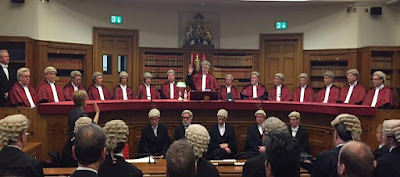 Scotland’s judiciary - elderly, white, rich and male. CALLS to promote diversity within Scotland’s predominantly elderly, white, wealthy judiciary will not be significantly advanced by today’s publication of recommendations by the Law Society of Scotland to widen the club class ranks of Senators of the Court of Session, Sheriffs & even the occasional JP.
Scotland’s judiciary - elderly, white, rich and male. CALLS to promote diversity within Scotland’s predominantly elderly, white, wealthy judiciary will not be significantly advanced by today’s publication of recommendations by the Law Society of Scotland to widen the club class ranks of Senators of the Court of Session, Sheriffs & even the occasional JP.
Scotland’s judiciary - many of whom share the same private school backgrounds and jealously guard their secretive earnings & business interests need fear not for any impending change to their club class ranks and tap on the shoulder techniques for recruitment.
The latest instalment on judicial diversity, in which the Law Society promotes outreach work in schools, mentoring and reviewing the current skill set for sheriffs and judges as a method of creating a more diverse judiciary means current ways will be preserved for a few pounds years more – much to the relief of the many ermine clad ranks of Scotland’s current judicial fraternity.
Law Society publishes recommendations to improve diversity in Scotland’s judiciary
The Law Society of Scotland has published a series of recommendations in a paper responding to a judicial appointments diversity steering group (DSG) report on its conference ‘Merit and diversity – Compatible aspirations in judicial appointments?’.
 The Law Society, a member of the DSG, believes that while good progress has been made in increasing diversity within the judiciary, more can be done to bring about further improvement.
The Law Society, a member of the DSG, believes that while good progress has been made in increasing diversity within the judiciary, more can be done to bring about further improvement.
Rob Marrs, head of education at the Law Society, said: “There have been great strides made since the inception of the Judicial Appointments Board for Scotland in improving transparency in the appointments process and other more recent changes resulting from the conference held last year on merit and diversity within the judiciary, including a review of its application process to make it more accessible and increased engagement and outreach work with interested parties.
“However it’s undeniable that there is currently a lack of diversity in our judiciary and, with men making up more than 70% of judicial posts, it is not representative of the legal profession or of the population at large.
“Our key recommendations include reviewing the existing criteria for judicial appointments and examining if there are unnecessary barriers which prevent potential candidates from applying. It’s important that as well as considering those recommended for appointment, we look at what can be done to broaden the pool of potential candidates.
“We also think there should be more consideration given to career development and ensuring that judicial appointment is an attractive option for a range of would-be candidates. This could include developing a distinct judicial career path– a model adopted in several European jurisdictions – with specific training for advocates and solicitors who are interested in a career on the bench.
“Informing and engaging groups who may be interested in becoming a sheriff or a judge should start at the earliest opportunity and there could be outreach work done in schools, during university and at the early stages of people’s legal careers. Providing shadowing and mentoring opportunities for less well represented groups has also worked well in England and Wales, where there has been a lot of work done on this, and could easily be adopted here to encourage those who may not previously have considered applying for judicial appointment.”
The Law Society has also recommended a review of the current criteria and eligibility for those who can apply for a judicial appointment.
Marrs said: “It’s important that we consider the attributes needed by those on the bench. For example, at the moment a key part of the criteria to become a sheriff is experience in court work and case presentation skills. This means that more court practitioners will apply as they can more easily provide evidence to meet the required competencies for the role. However, while this type of experience may be highly desirable, it is important to consider the full range of skills required to prevent any artificial barrier to potential appointment.
“In our view the relevant competencies for a judicial appointment are the ability to make good reasoned decisions within a reasonable time frame, knowledge of the law, knowledge of the rule of law and court procedure. These sit alongside the ability to deal with and understand those appearing before them and to be able to communicate complicated concepts in straightforward language – something which could become increasingly important if more people choose to represent themselves in court if they are unable to access legal aid.”
The Law Society has also recommended having specialist judges who have an in depth knowledge of certain areas of law and a review of the current barriers in place which prevent tribunal judges, who are experienced in dealing with highly complex cases, from moving to judicial posts in Scotland’s courts.
“Our paper sets out several areas where we think there are opportunities to improve diversity within our judiciary. Instigating change will take a coordinated approach from all the organisations which are involved or have an interest in judicial appointments and I look forward to discussing our ideas in more detail with them.”
The Judicial Appointments Diversity Steering Group (DSG) is a collaborative group of organisations with an interest in diversity in the judiciary. Its diversity conference report is available to read on the Judicial Appointments Board website: Judicial Appointments Diversity Steering Group report.
No comments:
Post a Comment